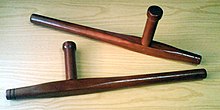Tonfa


The tonfa (
History
Traditional origin story
The tonfa belongs to a group of ancient weapons called
Regional variants

Although the tonfa is most commonly associated with the Okinawan martial arts, its origin is heavily debated. One of the most commonly cited origins is China, although origins from

Types of tonfa
There are different versions of the Okinawa tonfa but the basic design is the same. The small grip is at one end of the tonfa. The main body of the tonfa is where there are variations. The most popular form of tonfa has rounded sides and a rounded bottom which makes a semicircle. The square tonfa has rectangular faces on the main body of the weapon. A paddle-shape tonfa has the bottom half wider than the front half and looks like a paddle. Another tonfa has a rounded body throughout. A crude pointed tonfa has the front heads and back heads ending in a pointed design. This can be used for stabbing defense.[10]
Usage
The tonfa can be used for blocking and striking.
Blocking techniques involve a sidestepping maneuver. This allows the block to stop the attack while providing a way to gain entry. The block can be used to block high attack and low attacks.[5]
See also
- Okinawan weapons
- Hungarian shield
- Salawaku
- Side-handle baton
References
- ^ "Rare Kung Fu Weapons | Specialty Weapons".
- ^ "Weapons – Tonfa". Lyon Karate. Retrieved 29 May 2017.
- ^ a b c "Tonfa history". Tonfa.org. Archived from the original on 14 June 2017. Retrieved 29 May 2017.
- ^ Randal, J. (1994, June). Tricky Tonfa Techniques. Black Belt, 100-106.
- ^ a b Yamashita, T. (1987). Advanced Tonfa: Japanese Weapon of Self-defense. Spain: Black Belt Communications, Incorporated.
- ^ a b David (11 February 2009). "A Brief History of the Tonfa". japanesejujitsu.org. Archived from the original on 15 January 2018. Retrieved 29 May 2017.
- ^ a b "History". cs.canisius.edu. Archived from the original on 14 May 2016. Retrieved 29 May 2017.
- ^ a b c d "Tonfa". RKAGB. 4 June 2016. Retrieved 29 May 2017.
- ^ Nghia, S. (2017, February 19). song xỉ - binh khí nhà Tây Sơn. Vietnam Pictorial. Retrieved January 17, 2022, from https://vietnam.vnanet.vn/vietnamese/song-xi---binh-khi-nha-tay-son/274089.html
- ^ ISBN 0897500806.
Further reading
- ISBN 978-2-7027-0667-1.
